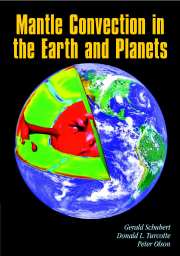Book contents
- Frontmatter
- Contents
- Preface
- 1 Historical Background
- 2 Plate Tectonics
- 3 Structure and Composition of the Mantle
- 4 Mantle Temperatures and Thermodynamic Properties
- 5 Viscosity of the Mantle
- 6 Basic Equations
- 7 Linear Stability
- 8 Approximate Solutions
- 9 Calculations of Convection in Two Dimensions
- 10 Numerical Models of Three-dimensional Convection
- 11 Hot Spots and Mantle Plumes
- 12 Chemical Geodynamics
- 13 Thermal History of the Earth
- 14 Convection in the Interiors of Solid Planets and Moons
- 15 Nature of Convection in the Mantle
- References
- Appendix: Table of Variables
- Author Index
- Subject Index
14 - Convection in the Interiors of Solid Planets and Moons
Published online by Cambridge University Press: 15 December 2009
- Frontmatter
- Contents
- Preface
- 1 Historical Background
- 2 Plate Tectonics
- 3 Structure and Composition of the Mantle
- 4 Mantle Temperatures and Thermodynamic Properties
- 5 Viscosity of the Mantle
- 6 Basic Equations
- 7 Linear Stability
- 8 Approximate Solutions
- 9 Calculations of Convection in Two Dimensions
- 10 Numerical Models of Three-dimensional Convection
- 11 Hot Spots and Mantle Plumes
- 12 Chemical Geodynamics
- 13 Thermal History of the Earth
- 14 Convection in the Interiors of Solid Planets and Moons
- 15 Nature of Convection in the Mantle
- References
- Appendix: Table of Variables
- Author Index
- Subject Index
Summary
Introduction
Space missions have provided extensive information on the other planets and the planetary satellites of the solar system. Like the individual islands in an archipelago, the terrestial planets share many characteristics and yet retain striking individuality. For example, it appears that active plate tectonics is unique to the Earth. In contrast, the Moon and Mercury have continuous lithospheres, with surfaces shaped largely by impacts and volcanic processes. Although impact cratering and volcanism have also been prevalent on Mars, its surface has also been modified by its atmosphere and the flow of a surface fluid, presumably water. Cloud-covered Venus has been exposed to the eyes of Earth-based and spacecraft radar systems. Cratering and volcanism have apparently left their marks on its surface, but there is no direct evidence of plate tectonic features such as extensive ridge or trench systems. The Galilean satellites of Jupiter are different from the inner planets and each other in puzzling ways. Ganymede and Callisto are icy satellites (half ice and half rock) whose surfaces have been modified by impacts, and, in the case of Ganymede, by tectonism. Callisto's surface shows no signs of endogenic activity, while Ganymede's surface shows no evidence of plate tectonics. Both of these Jovian moons have continuous water ice lithospheres. Europa is a mainly silicate moon of Jupiter, but Europa also has an outer layer of water ice/liquid. The surface of Europa is covered by ice, but there is a possibility that a liquid water ocean may exist beneath the ice. Europa's surface has been altered by impacts, tectonism, and cryovolcanism, but there is no evidence of global plate tectonics. Io is a silicate body, apparently lacking water.
- Type
- Chapter
- Information
- Mantle Convection in the Earth and Planets , pp. 633 - 766Publisher: Cambridge University PressPrint publication year: 2001

